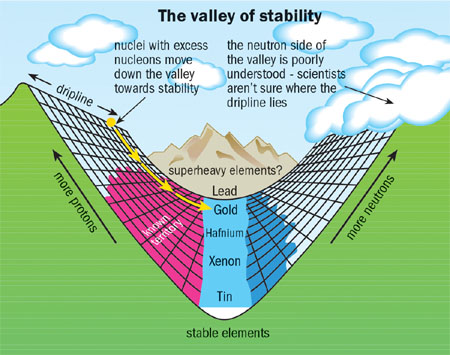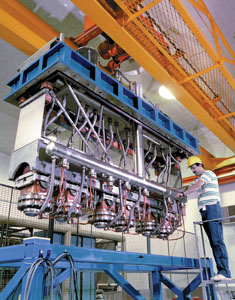With nuclear physics largely confined to a narrow band of stable isotopes, a new US machine aims to provide a wider nuclear perspective.
Though physicists have probed the subatomic world for many decades, it is easy to forget that our understanding of the atomic nucleus is largely limited to studies with stable isotopes. An innovative, exotic-beam facility now under consideration – the Rare Isotope Accelerator (RIA) – could extend the horizons of nuclear physics greatly. RIA will enable broader-based research with high-quality energetic beams of short-lived isotopes.

Of the thousands of known nuclear species, only about 300 are stable, that is they exist along the so-called “valley of stability”. The unstable species forming the valley “walls” – those with an overabundance of protons or neutrons – tend to decay quickly, sometimes within milliseconds.
The Organization for Economic Cooperation and Development’s Megascience Forum has recognized that beams of exotic radioactive isotopes have the potential to open up important, untapped opportunities for fundamental research, because studies of such ephemeral nuclear species by other means has been at best difficult and in most cases impossible.
Responding to these scientific opportunities, the US Nuclear Science Advisory Committee is recommending RIA as the highest priority for major new construction in its 2001 long-range plan for nuclear science. RIA will provide physicists with a powerful tool to complement the long-standing investigations of unstable nuclei at CERN’s ISOLDE and other laboratories. It will augment these other facilities not only by creating, but also by accelerating a range of short-lived nuclei that will provide a panoramic view from atop the “walls”, overlooking the “valley of stability”. Fundamental research in several fields would be addressed at RIA, including:
•The nature of nucleonic matter RIA will allow the close examination of the many nuclei that are very far from stability and about which little is known. Such studies will provide fundamental insights into nuclear structure and interactions that are not manifest in species near stability.
•The origin of the elements Nearly all of the chemical elements in the universe are forged in the interiors of stars, but the chain of events and even the astrophysical sites that produce them are still poorly understood. RIA will permit researchers to investigate the metamorphoses that nuclei undergo in these cosmic cauldrons.
•The Standard Model While high-energy accelerators are needed in direct searches for undiscovered particles like the Higgs boson, physicists will use RIA to explore with greater precision the known subatomic particles and the forces that act on them.
•Nuclear medicine A third of all patients hospitalized in the US undergo a nuclear medicine procedure. All such procedures require isotopes that are produced in reactors or small accelerators. RIA will bring a new level of technology for the rapid production and exploration of medical isotopes that have specific physical and chemical properties.
Building RIA will require innovations based on current accelerator technology, and researchers at several US institutions are already working to bridge this gap.
Limitations of current technology
There are currently two methods designed for probing unstable isotopes, each of which is limited in its scope. In the first – isotope separation on line (ISOL) – a driver beam of stable ions strikes a heated target. By means of either fission or spallation, the impact produces unstable nuclei at low energy. This “stopped beam” technique has proved useful in recent investigations into the Standard Model at CERN’s ISOLDE. This is a slow process, so many isotopes, especially those of refractory and chemically active elements, decay before they can be reaccelerated for study.
The second method of probing unstable isotopes solves some of the problems but creates others. A driver beam of heavy ions strikes a thinner target of light material, which makes the energetic ions fragment like shrapnel from a fast-moving projectile. These high-energy fragments do not require such time-consuming reacceleration but there is greater beam divergence and energy variation than in beams produced by ISOL. The two methods are considered complementary but, even when both are used, researchers are limited in their ability to produce high-quality beams of rare nuclear species.

RIA will allow physicists to have the best of both worlds, providing them with energetic, high-quality beams of essentially any isotope. An innovation based on the new “fast gas-catcher” technology will be necessary to overcome the limitations of the ISOL and in-flight projectile fragmentation methods. This technology was recently developed and put to use for research at Argonne’s ATLAS facility.
The technique magnetically separates exotic ions produced in thin targets and brings them to rest in a fast gas-catcher that is filled with pressurized helium. Normally these ions, which are positively charged, would neutralize themselves by capturing electrons from surrounding atoms. However, helium electrons are the most tightly bound of any element and the stopped ions remain positively charged. They are then extracted and reaccelerated so that all of the ions have uniform energy and small divergence.
The whole process – from target to gas cell to post accelerator – occurs in a matter of milliseconds. This new separation technology, in combination with the powerful new driver and efficient post accelerators, will give physicists high-quality beams of exotic isotopes of all elements from lithium to uranium.
Innovations in accelerator and target technology
Along with an increase in flexibility will come an increase in power – RIA will be able to produce beams of exotic nuclei that are far more intense than any that are available now. One of the secrets of producing this intensity will be the acceleration of more than one “charge state” of ions at a time.
Isotopes are typically stripped of many electrons before they are accelerated into a beam, turning them into positively charged ions. Ordinarily, accelerators have worked best with ions of one specific charge, but many nuclei come out of the ion source and strippers with a greater or smaller number of electrons than desired. Usually a single “charge state” is selected from the mixture – a process that severely limits the available heavy-ion beam intensities.
Argonne scientists have demonstrated that the driver linac can be configured to accelerate several charge states simultaneously. Experiments at ATLAS have confirmed that RIA’s beam intensity can be increased eight times by capturing and accelerating multiple charge states after the strippers. Plans have also been worked out to accelerate two charge states directly from the ion source. In combination, this would boost the power of RIA’s driver beam by a factor of 16 for the heaviest ions.
Such intense beams would quickly destroy a traditional solid target, so Argonne designers are developing a liquid target that can withstand the beam. Adapting an idea that was originally proposed for removing heat from a fusion reactor, the beam will shine on a stream of liquid lithium, which flows in a closed loop through a heat exchanger to dissipate the high beam power.
At this time, Argonne and Michigan State University are working together to develop a cost-effective plan for the construction of RIA. A workshop on potential applications of the accelerator was jointly sponsored by Los Alamos and Lawrence Livermore National laboratories in September 2000. Currently, seven US laboratories are participating in RIA research and a national committee is coordinating the ongoing research and development effort. This technical progress will ensure that RIA can achieve the promising scientific goals of the nuclear community.
Further Information
Traditional radioactive beam facilities
The ISOL method for producing, separating and studying the decays of radioactive isotopes has been in use since a pioneering experiment in Copenhagen in 1951. ISOL work has been carried out vigorously at the CERN ISOLDE facility for more than 30 years. Innovative work at Louvain-la-Neuve in Belgium made post-accelerated radioactive beams available.
At TRIUMF in Vancouver a powerful new ISOL-type facility – ISAC – was recently commissioned. It now delivers post-accelerated beams for research. A post-accelerator was also recently commissioned at CERN’s ISOLDE as part of the REX-ISOLDE experiment. Planning and R&D for an advanced ISOL-type radioactive beam facility for Europe is currently in progress.
The fragmentation method for the in-flight separation of short-lived rare isotopes was pioneered at the Berkeley Bevalac facility in the late 1970s. One advanced facility – based on the heavy-ion fragmentation method – is under construction at RIKEN in Japan and another is being proposed for GSI in Germany. Both of these new fragmentation facilities plan to use storage rings to expand the types of research that can be done with the rare isotopes. Other fragmentation facilities include those recently upgraded at Michigan State University in the US and GANIL in Caen, France.
RIA’s technical capabilities

RIA brings together a range of technologies to produce intense and high-quality beams of short-lived radionuclides of all of the chemical elements – from the lightest to the heaviest. The short-lived, rare isotopes are produced by a continuous-wave, superconducting 1.4 GV driver linac that will deliver 400 kW beams of any mass from 900 MeV protons to 400 MeV per nucleon uranium. The schematic layout is shown in figure 2.
The main production mechanisms are spallation and fission of heavy targets by light ions, and in-flight fragmentation or fission of heavy-ion beams.
RIA will provide facilities for research with rare isotopes in four energy regimes (stopped beams; ~1 MeV/nucleon reaccelerated beams; ~10 MeV nucleon reaccelerated beams; ~400 MeV/nucleon secondary beams of in-flight fragments). This flexibility will make RIA a valuable addition to existing exotic beam facilities. RIA is also a potential source of both ultracold neutrons and continuous-wave, high-energy neutron beams for a variety of basic and applied research programmes.








